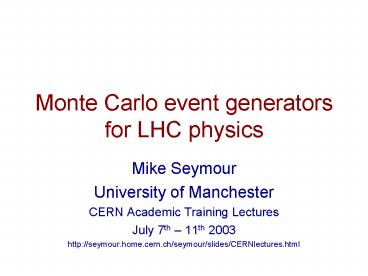Monte Carlo event generators for LHC physics PowerPoint PPT Presentation
1 / 27
Title: Monte Carlo event generators for LHC physics
1
Monte Carlo event generators for LHC physics
- Mike Seymour
- University of Manchester
- CERN Academic Training Lectures
- July 7th 11th 2003
- http//seymour.home.cern.ch/seymour/slides/CERNlec
tures.html
2
Structure of LHC Events
- Hard process
- Parton shower
- Hadronization
- Underlying event
3
Monte Carlo for the LHC
- Basic principles
- Parton showers
- Hadronization
- Monte Carlo programs in practice
- Questions and answers
4
Parton Showers Introduction
- QED accelerated charges radiate.
- QCD identical accelerated colours radiate.
- gluons also charged.
- ? cascade of partons.
- parton shower.
- annihilation to jets.
- Universality of collinear emission.
- Sudakov form factors.
- Universality of soft emission.
- Angular ordering.
- Initial-state radiation.
- Hard scattering.
- Heavy quarks.
- The Colour Dipole Model.
5
annihilation to jets
- Three-jet cross section
- singular as
- Rewrite in terms of quark-gluon opening angle
and gluon energy fraction - Singular as and .
6
- can separate into two independent jets
- jets evolve independently
- Exactly same form for anything
- eg transverse momentum
- invariant mass
7
Collinear Limit
- Universal
- Dokshitzer-Gribov-Lipatov-Altarelli-Parisi
splitting kernel dependent on flavour and spin
8
Resolvable partons
- What is a parton?
- Collinear parton pair single parton
- Introduce resolution criterion, eg
- Virtual corrections must be combined with
unresolvable real emission - Unitarity P(resolved) P(unresolved) 1
Resolvable emission Finite Virtual
Unresolvable emission Finite
9
Sudakov form factor
- Probability(emission between and
) - Define probability(no emission between and
) to be . Gives evolution equation - c.f. radioactive decay
- atom has probability per unit time to decay.
- Probability(no decay after time T)
10
Sudakov form factor
- Probability(emission between and
) - Define probability(no emission between and
) to be . Gives evolution equation - Sudakov form factor Probability(emittin
g no resolvable radiation)
11
Multiple emission
But initial condition? Process dependent
12
Monte Carlo implementation
- Can generate branching according to
- By choosing uniformly
- If no resolvable radiation,
evolution stops. - Otherwise, solve
- for emission scale
- Considerable freedom
- Evolution scale
- z Energy? Light-cone momentum?
- Massless partons become massive. How?
- Upper limit for ?
All formally free choices, but can be very
important numerically
13
Running coupling
- Effect of summing up higher orders
- absorbed by replacing by
- Much faster parton multiplication phase space
fills with soft gluons. - Must then avoid Landau pole
- now becomes physical parameter!
14
Soft limit
- Also universal. But at amplitude level
- soft gluon comes from everywhere in event.
- Quantum interference.
- Spoils independent evolution picture?
15
Angular ordering
- NO
- outside angular ordered cones, soft gluons sum
coherently only see colour charge of whole jet. - Soft gluon effects fully incorporated by using
as evolution variable angular ordering - First gluon not necessarily hardest!
16
Initial state radiation
- In principle identical to final state (for not
too small x) - In practice different because both ends of
evolution fixed - Use approach based on evolution equations
17
Backward evolution
- DGLAP evolution pdfs at as function
of pdfs at
Evolution paths sum over all possible
events. Formulate as backward evolution start
from hard scattering and work down in up in
towards incoming hadron. Algorithm identical
to final state with replaced by
18
Hard Scattering
- Sets up initial conditions for parton showers.
- Colour coherence important here too.
- Emission from each parton confined to cone
stretching to its colour partner - Essential to fit Tevatron data
19
- Distributions of third-hardest jet in multi-jet
events - HERWIG has complete treatment of colour
coherence, - PYTHIA has partial
20
- Distributions of third-hardest jet in multi-jet
events - HERWIG has complete treatment of colour
coherence, - PYTHIA has partial
21
Heavy Quarks/Spartons
- look like light quarks at large angles, sterile
at small angles - implemented as energy-dependent cutoff
- The dead cone. Too extreme?
22
The Colour Dipole Model
- Conventional parton showers start from collinear
limit, modify to incorporate soft gluon coherence - Colour Dipole Model start from soft limit
- Emission of soft gluons from colour-anticolour
dipole universal (and classical) - After emitting a gluon, colour dipole is split
23
- Subsequent dipoles continue to cascade
- c.f. parton shower one parton ? two
- CDM one dipole ? two two partons ? three
- Represented in origami
- diagram
- Similar to angular-ordered parton shower for
annihilation
24
Initial-state radiation in the CDM
- There is none!
- Hadron remnant forms colour dipole with scattered
quark. - Treated like any other dipole.
- Except remnant is an extended object suppression
Biggest difference relative to angular-ordered ?
more radiation at small x
25
The Programs
- ISAJET ordering no coherence huge range
of hard processes. - PYTHIA ordering veto of non-ordered final
state emission partial implementation of angular
ordering in initial state big range of hard
processes. - HERWIG complete implementation of colour
coherence NLO evolution for large x smaller
range of hard processes. - ARIADNE complete implementation of colour dipole
model best fit to HERA data interfaced to
PYTHIA for hard processes.
26
Summary
- Accelerated colour charges radiate gluons.
- Gluons are also charged ? cascade.
- Probabilistic language derived from factorization
theorems of full gauge theory. - Colour coherence is a fact of life do not trust
those who ignore it! - Modern parton shower models are very
sophisticated implementations of perturbative
QCD, but would be useless without hadronization
models
27
Reminder FAQs
- Lecture 5, Friday 11th July
- Question and Answer session
- Email questions to M.H.Seymour_at_rl.ac.uk
- Cutoff Thursday 10th July, 2pm
- http//seymour.home.cern.ch/seymour/slides/CERNlec
tures.html

